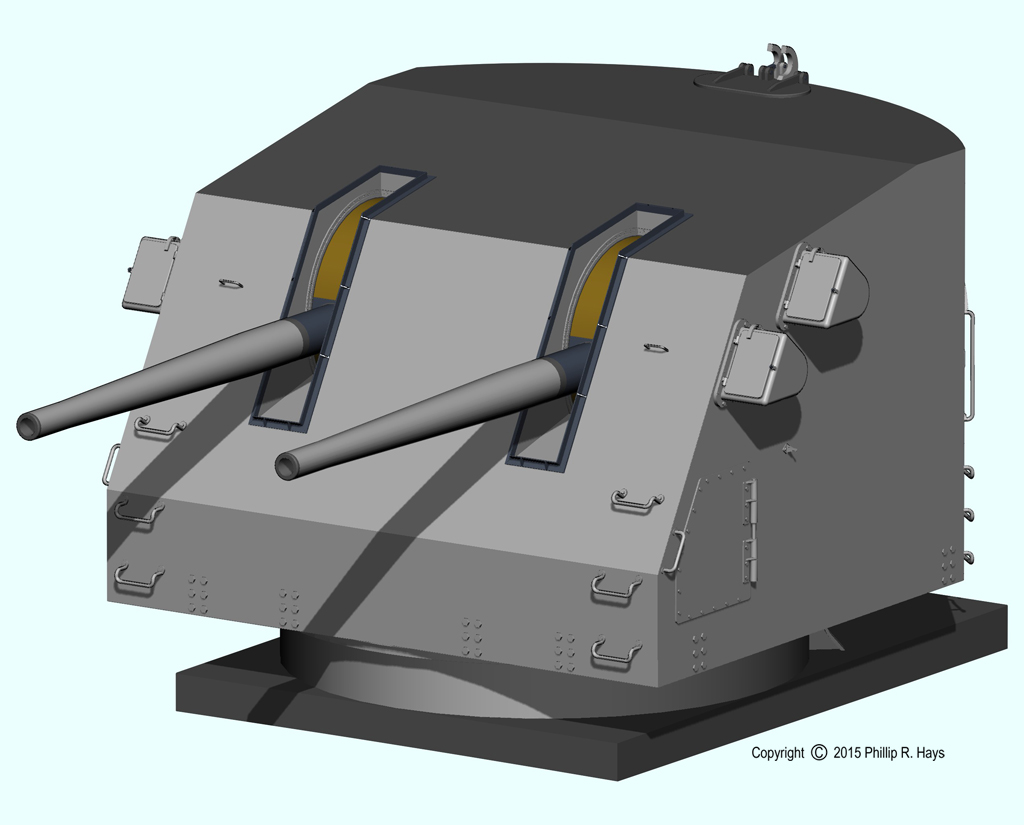The American entry for this project is the most difficult to do. I already have two AU drawings of US CB/BC units with the Alaska and Hawaii plus there are countless drawings and variations done by Ian Roberts and others of the real life Alaska Class. The second part is what armament to fit to it. Do I create a new set of weapons for the class. Do I use already made weapons with the 14" and 16" of WW1 manufacture. The main thought I considered following was a new 14" weapon. During the early 1930's the British were pushing for a reduction of main armament size from 16" to 14" (see King George V) which as it turned out the British were the only country to build 14" armed ships. The US followed its triple 16" armed ships and never produced a new 14" gun type. So what it the US had followed the British lead and did design work on both 14" and 16" weapons, putting off the final decision to the last minute.
It is the Deutschland and Scharnhorst class ships and also the Kongo class that fuelled the American interest in CB/BC units as the ships they had were just not fast enough to catch those types. Even the new construction of the Washington class were not fast enough. What was needed was a new 30-32,000 ton design with 14" guns of a modern type that could catch and dispatch enemy raiders. Now why does that sound familiar? What I will try to end up with is a fast battleship rather than the Alaska type which was more armed and armoured like a large cruiser.

The four Kongo class being refurbished during the 1930's gave the Japanese a decided advantage over the US forces of the time. Making 30+ knots the Kongo's would have been able to work with their cruisers and would have outfought any cruiser the US Navy could have put into the field. The US Navy did not want to go down the battlecruiser type of ship as they had seen what had happened to them in the First World War. What they wanted to create was a slightly faster version of the Washington class battleships, by reducing the armament and armour by a small amount. One thing that looks odd compared to other ships of the time was a hull with no portholes. The US Navy being the first to introduce air-conditioning throughout the hull but still had portholes in the upper superstructure.
What came out of the bureau of design as the four ship Guam class, were powerful ships, which fulfilled all the US Navy could have wanted of them. Around the Solomon Islands Battles, the class came of age and proved themselves in two night actions where the Japanese were using Kongo class battlecruisers to cover attacks on Henderson Airfield, on Guadalcanal, and the Allied cruisers guarding the area.
Neither side in the Pacific War ever had enough aircraft carriers, so both sides built airfields on the islands they had under their control. Both sides went to capture the islands with these airfields on them to deny the enemy any advantage. When the Allies heard that the Japanese were just finishing off a new airfield on Guadalcanal Island, plans were quickly made and executed to capture the airfield. From there started a series of battles both at sea and on land for control of Henderson Field. The Japanese introduced the Kongo class ships to bombard the airfield and sink any interfering Allied cruisers. These attacks had to take place under cover of darkness as the aircraft from the airfield made any Japanese daylight actions impossible to achieve. Allied recon aircraft from the airfield were able to spot the Japanese forces leaving the Islands to the north which gave the Allies time to set up a reception committee for whatever was coming. When the Japanese battlecruisers were spotted, Admiral Lee with his two battleships Guam and Puerto Rico were detached from guarding Admiral Halsey's carriers and sent to stiffen the resistance off Henderson Field.
The after action report used the words "Shot the two Japanese battlecruisers to bits". In a brisk action the Guam and Puerto Rico watched on their RADAR as the two Japanese ships entered the arena like blind men coming to be executed. At point blank range the USN ships opened fire. The faster firing guns using bigger shells than their opponents really did just shoot them to bits. Both Japanese battlecruisers were silenced, their armaments put out of action with both ships burning. The Puerto Rico received a torpedo hit which forced the USN ships to withdraw before they could finish off their opponents. Aircraft from the USN carriers and Henderson Field sank the wrecks the next day.
